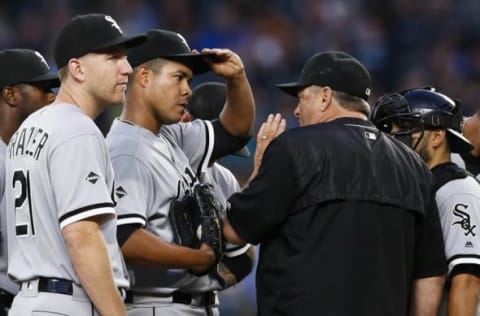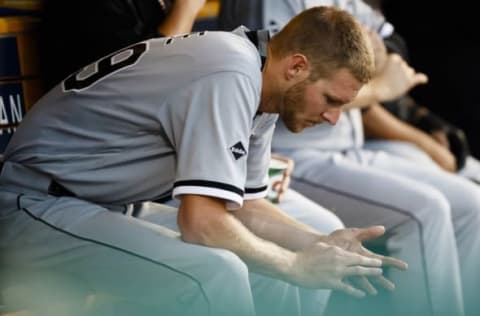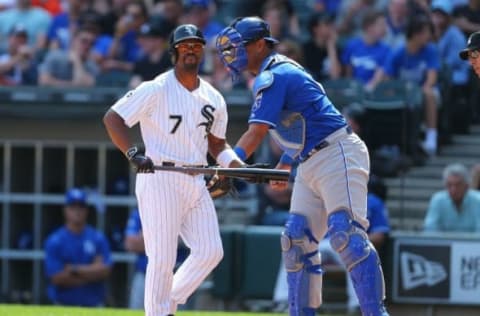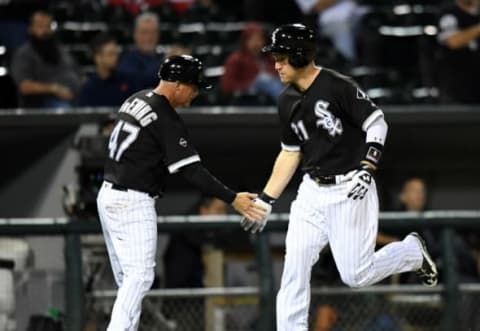Chicago White Sox: Top Five Priorities for the 2016-17 Offseason


For the fourth straight year, the Chicago White Sox finished another regular season with an under-.500 record. Should the team start to rebuild or attempt to retool and make another run at the postseason?
In the first big development of their offseason, the Chicago White Sox have switched managers from Robin Ventura to bench coach Rick Renteria. Ventura had managed the team for the past five years, but often faced criticism of fans and media alike as he never reached the postseason and had led the White Sox to only one winning season during his tenure.
Perhaps fans are unsure about the switch because President Kenny Williams and General Manager Rick Hahn have decided to stay in-house instead of bringing a fresh set of eyes into the organization.
However, this move doesn’t overtly signal how the White Sox are going to approach this offseason. The front office could certainly feel that a couple of moves may make them a contender again. But there is also a feeling that a rebuild is needed to replenish the organization’s farm system that sat near the bottom of Baseball America’s organizational talent rankings.
It’s already been a few seasons since the White Sox played competitive baseball in September so choosing to tear everything down may not sit well with fans looking to get back to the postseason in short order. The White Sox aren’t completely barren in terms of talent, but team management is going to have to make a concerted effort to get better this offseason if they hope to make the playoffs next season.
1. Pick a Side

It’s been a season-to-season quandary for the White Sox with how much they should go all-in to making a playoff run. We’ve seen teams go all-in with much success like the Blue Jays did by trading for David Price and Troy Tulowitzki in 2015. However, we’ve also seen clubs like the San Diego Padres and Arizona Diamondbacks set their organizations back years because of a false sense of going all-in.
Chicago is in the exact territory right now. Do they decide to ship off one or both of their top starting pitchers? Do they hold onto Todd Frazier, who will be a free agent after next season? What about David Robertson‘s fate? He was frequently mentioned in trade rumors over the summer.
One thing is for certain, Rick Hahn and his front office must choose a concrete direction. Over the past few seasons the White Sox have managed to stay in the middle by acquiring a few veterans, but not deciding to trade key pieces when they had the opportunity to. Not trading Jeff Samardzija comes to mind as a move that perfectly describes what the White Sox have been over the past few years.
Obviously, figuring out what to do with Chris Sale and Jose Quintana is priority number one. But how they handle those trade discussions is going to be an overall signal about what approach the White Sox will take this winter. Sale is under team control for three more seasons and Quintana has about four years left on his contract when factoring team options. These two would bring back immense value if the White Sox decided to go in that direction. However, without them, it’s tough to imagine any world where the club would be competitive over the next three years.
Chicago must choose whether to retool or rebuild, but they certainly can’t continue to just tread water.
2. What Is Carson Fulmer?

When looking at how the White Sox approach the draft, a clear trend emerges. Not only do they take high level college talent often, but they also have the tendency to push those guys to the major leagues. That philosophy has never been clearly when looking at how they handled their 2014 and 2015 first round picks.
A few years ago, the White Sox took former North Carolina St. pitcher Carlos Rodon with the third overall pick. About a year later, the then 22-year-old was making his debut in the major leagues. This season Rodon was a full-time starter who performed admirably behind Sale and Quintana in the club’s starting rotation.
Things have not gone as well for their 2015 first round pick Carson Fulmer. Like Rodon, Fulmer has tremendous pure stuff and pitched for one of the premier baseball programs in the country at Vanderbilt. White Sox brass also pushed him through the minors and he found himself on the big league roster just a year out from being drafted.
Former manager Robin Ventura placed the 22-year-old right-hander in the bullpen, but the results were shaky to say the least. In eight appearances as a relief pitcher he surrendered 11 earned runs, walked seven and struck out ten. So while his putout numbers were fairly solid given his power stuff, his walk rate of 5.4 batters per nine innings is going to have to be improved upon.
What Rick Renteria is going to have to figure out is whether Fulmer is a future back-of-the-bullpen guy or whether he will be a starter long-term. There was much debate with Fulmer heading into the draft because while his stuff is elite, there were questions about his consistency and whether he could sustain in a starting role. This season didn’t quiet those concerns as he struggled with command and looked out-of-place at the major league level.
The White Sox pushed Rodon into the starting rotation two years out from being drafted, but will they do the same with Fulmer? If it were up to me, I would give him a shot at cracking the starting rotation. His stuff is too good to not afford him the opportunity to prove himself in a starting role. If need be, he can start next year in the minors and work on becoming a more consistent pitcher. Then if he continues to falter, stick him in the bullpen and see what happens.
3. Don’t Sign Any More Veteran Gap-Fillers

If the White Sox want to turn around their fortunes in 2017, then they are going to have to take a much different approach with signing veteran players than they did last offseason.
Chicago had multiple needs going into the winter last year and they decided to turn to the short-term veteran free agent market in order to fill many of them. Jimmy Rollins was signed to be the club’s starting shortstop at 37 years of age. Mat Latos was taken off the scrap heap on a “prove it” one-year contract. Veteran backstops Dioner Navarro and Alex Avila were brought in to split duties behind the plate. Journeyman Austin Jackson was acquired to be the team’s starting center fielder. Heck, the White Sox even signed Justin Morneau midseason to plug into the designated hitter spot.
It’s an exhaustive list that cannot be repeated this go-around. While signing one or two veteran guys to help supplement the team is not a bad thing, normally building your team around many of these players does not build confidence when it comes to actually competing.
With many of these players leaving for free agency again this offseason, it would do the White Sox well to not play in this market again. They would be wise to try to repeat moves like trading for players like Brett Lawrie, talented younger players that have a few years of control.
At this point, the White Sox have holes in the starting rotation, center field, catcher and designated hitter. Signing one veteran fill-in would be fine, but they can’t do what they did last offseason regardless of what direction they choose to take in terms of rebuilding or making a run at the postseason.
4. Make a Run at Ian Desmond or Dexter Fowler (If Retooling)

Let’s say that the White sox brass want to try to compete in 2017. If that’s the case, making a run at one of the talented center fielders available would be the best option.
This upcoming free agent class is rather bare on the pitching market so spending big money on an arm would probably not do much good, especially combined with the fact that the team is going to have to pay James Shields $22 million over the next two seasons.
That’s what makes Ian Desmond and Dexter Fowler perfect players to chase this winter. Yes, both have been inconsistent over the course of their careers. It’s also true that they are going to have to spend big money to fend off other teams for their services. However, when looking at the numbers both put up this season, I would say that it’s a wise investment.
Both of them will be in their early 30s going into next season, so they still will be playing in their prime years for at least a few seasons over the contract the White Sox would have to give them. Also, both fit very well within the White Sox’s lineup right now.
If the team were to sign Desmond, he would be a good player to protect Jose Abreu in the middle of the lineup. On the other hand, Dexter Fowler would do nicely at the top of the order with Adam Eaton.
I would say that a deal in the range of four years and $80 million would be a reasonable contract for both. Even if another team comes in and blows up the market for these guys, I would have no problem giving either a five-year contract for a little more money per year with the way both played this season.
Finding quality hitters that will consistently make an impact with the bat like these two do is tough. If the White Sox are looking to compete in 2017, beefing up their offense is going to be crucial and with the way the market looks to be shaping up, signing one of these outfielders seems like one of the better investments out there.
5. Trade Todd Frazier (If Rebuilding)

Having power is crucial for any team at the major league level and it’s something that many clubs will go out of their way to target during the offseason. The White Sox would have one of the better power bats available if team management decided that they would rather start a rebuild.
Todd Frazier was traded to the White Sox last offseason in a three-team deal with the Reds and Dodgers. Chicago gave up a solid young pitcher in Frankie Montas to get the deal done, so the team was relying on Frazier to do a lot for the club in 2016.
More from Call to the Pen
- Philadelphia Phillies, ready for a stretch run, bomb St. Louis Cardinals
- Philadelphia Phillies: The 4 players on the franchise’s Mount Rushmore
- Boston Red Sox fans should be upset over Mookie Betts’ comment
- Analyzing the Boston Red Sox trade for Dave Henderson and Spike Owen
- 2023 MLB postseason likely to have a strange look without Yankees, Red Sox, Cardinals
So what were the results? Well, they were a mixed bag. Frazier was at the top of the league in terms of home run power as he finished the year with 40 long balls, which ranked eighth in MLB. But what Frazier did in the power department was greatly diminished by his overall offensive numbers.
The 30-year-old third baseman hit for a meager .225 batting average and only got on base at a clip of just over .300. Frazier also struck out 163 times in the regular season, which ranked 13th in the league. These aren’t encouraging numbers for a team that was relying on Frazier to be a middle-of-the-order bat.
However, there is no doubt in my mind that if he was surrounded by a better lineup, Frazier’s overall offensive output would look much better, and that’s what prospective teams are going to be relying on if they trade for the veteran third baseman.
If the White Sox really want to compete, it’s probably best to keep Frazier given that finding power at the levels he puts up is difficult. But if the White Sox decide that the playoffs are not in the cards for them in 2017, then they would do well to collect some value for a power hitter who will be a free agent at season’s end and is kind of wasted on his current ball club.
Next: Takeaways from White Sox 2016 Season
How do you think the White Sox should approach this offseason? Share your thoughts in the comment section below.